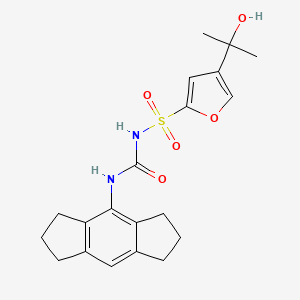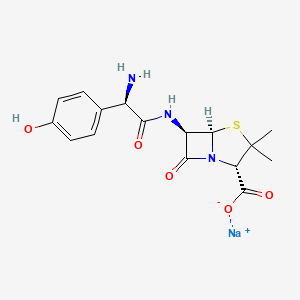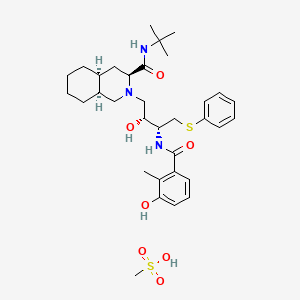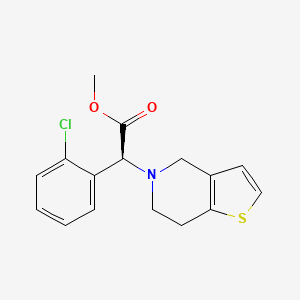
Clopidogrel
概要
説明
クロピドグレルは、主に高リスクの個体における心臓病および脳卒中のリスクを軽減するために使用される抗血小板薬です。 心臓発作を経験した患者または冠動脈ステント留置術を受けた患者には、アスピリンとの併用がしばしば処方されます . クロピドグレルはチエノピリジン系抗血小板薬に属し、血小板凝集を阻害することで作用します .
作用機序
クロピドグレルは、活性なチオール代謝物に体内変換されるプロドラッグです。 この活性代謝物は、血小板表面のアデノシン二リン酸受容体のP2Y12成分に不可逆的に結合します . この結合により、アデノシン二リン酸が糖タンパク質GPIIb/IIIa受容体複合体を活性化することができなくなり、血小板凝集が減少して血栓形成が阻止されます .
類似の化合物:
チクロピジン: 他のチエノピリジン系抗血小板薬ですが、副作用の発生率が高くなっています。
プラグレル: クロピドグレルよりも作用開始が早く、効力が強い、新しいチエノピリジン系薬剤です。
チカグレロ: P2Y12受容体を可逆的に阻害する、非チエノピリジン系抗血小板薬です。
クロピドグレルの独自性: クロピドグレルは、P2Y12受容体への不可逆的結合により、長時間の抗血小板効果を発揮します。 その有効性と安全性プロファイルが証明されているため、臨床現場で広く使用されています .
生化学分析
Biochemical Properties
Clopidogrel’s biochemical target is the purinergic receptor P2Y12 . In platelets, the P2Y12 receptor is coupled to the inhibitory G-protein Gi . The inhibition of platelet response to ADP is observed within 12 hours after this compound intake .
Cellular Effects
This compound has significant effects on platelets. It inhibits the function of the P2Y12 receptor, thereby preventing spontaneous platelet aggregation after percutaneous transluminal coronary angioplasty .
Molecular Mechanism
This compound is a prodrug that requires biotransformation into its active thiol metabolite by the cytochrome P450 enzymes . The active metabolite then inhibits the P2Y12 receptor on platelets, preventing platelet aggregation .
Temporal Effects in Laboratory Settings
In laboratory settings, aggregometry and VASP phosphorylation revealed a loss of platelet response to ADP within 12 hours after this compound intake . The phosphorylation status of VASP correlated with the inhibition of platelet aggregation .
Metabolic Pathways
This compound is metabolized by the cytochrome P450 enzymes, primarily CYP2C19, into its active form . The active metabolite then inhibits the P2Y12 receptor, affecting platelet aggregation .
準備方法
合成ルートおよび反応条件: クロピドグレルは、さまざまな方法で合成できます。 一般的なアプローチの1つは、1つ以上の溶媒中で、無水強塩基を使用して、R(-)クロピドグレルのラセミ化を行うことです . 別の方法には、硫酸の存在下、25〜40°Cの温度で、メタノールとアセトンを溶媒混合物とした溶液から、クロピドグレル硫酸塩を析出させることが含まれます . さらに、クロピドグレルは、L-2-クロロフェニルグリシンとメタノールを反応させてL-2-クロロフェニルグリシンメチルエステルを生成し、その後、一連の反応を経てクロピドグレルを得ることで調製できます .
工業生産方法: クロピドグレルの工業生産には、通常、ラセミ体クロピドグレルの光学分割を行い、活性なS(+)エナンチオマーを得ることが含まれます。 このプロセスには、高い収率と純度を確保するために、特定の試薬と条件を使用することが含まれます .
化学反応の分析
反応の種類: クロピドグレルは、酸化、還元、置換など、いくつかの種類の化学反応を起こします。
一般的な試薬と条件:
酸化: クロピドグレルは、制御された条件下で、過酸化水素または過マンガン酸カリウムなどの試薬を使用して酸化できます。
還元: 還元反応には、水素化ホウ素ナトリウムまたは水素化アルミニウムリチウムなどの還元剤を使用する場合があります。
置換: 置換反応には、適切な触媒の存在下で、ハロゲン化物またはアミンなどの求核剤を必要とする場合が多いです。
主要な生成物: これらの反応から生成される主要な生成物は、使用される特定の試薬と条件によって異なります。 たとえば、クロピドグレルの酸化により、さまざまな酸化代謝物が生成される可能性がありますが、置換反応により、クロピドグレルの異なる置換誘導体が生成される可能性があります。
4. 科学研究への応用
クロピドグレルは、さまざまな科学研究に応用されています。
科学的研究の応用
Clopidogrel has a wide range of scientific research applications:
Chemistry: this compound is used as a model compound in studies related to antiplatelet agents and their mechanisms of action.
Biology: Research on this compound focuses on its effects on platelet function and its role in preventing thrombotic events.
Medicine: this compound is extensively studied for its clinical applications in preventing heart attacks, strokes, and other cardiovascular events.
類似化合物との比較
Ticlopidine: Another thienopyridine antiplatelet agent, but with a higher incidence of adverse effects.
Prasugrel: A newer thienopyridine with a more rapid onset of action and greater potency compared to clopidogrel.
Ticagrelor: A non-thienopyridine antiplatelet agent that provides reversible inhibition of the P2Y12 receptor.
Uniqueness of this compound: this compound is unique due to its irreversible binding to the P2Y12 receptor, providing long-lasting antiplatelet effects. It is also widely used in clinical practice due to its proven efficacy and safety profile .
特性
IUPAC Name |
methyl (2S)-2-(2-chlorophenyl)-2-(6,7-dihydro-4H-thieno[3,2-c]pyridin-5-yl)acetate | |
|---|---|---|
| Source | PubChem | |
| URL | https://pubchem.ncbi.nlm.nih.gov | |
| Description | Data deposited in or computed by PubChem | |
InChI |
InChI=1S/C16H16ClNO2S/c1-20-16(19)15(12-4-2-3-5-13(12)17)18-8-6-14-11(10-18)7-9-21-14/h2-5,7,9,15H,6,8,10H2,1H3/t15-/m0/s1 | |
| Source | PubChem | |
| URL | https://pubchem.ncbi.nlm.nih.gov | |
| Description | Data deposited in or computed by PubChem | |
InChI Key |
GKTWGGQPFAXNFI-HNNXBMFYSA-N | |
| Source | PubChem | |
| URL | https://pubchem.ncbi.nlm.nih.gov | |
| Description | Data deposited in or computed by PubChem | |
Canonical SMILES |
COC(=O)C(C1=CC=CC=C1Cl)N2CCC3=C(C2)C=CS3 | |
| Source | PubChem | |
| URL | https://pubchem.ncbi.nlm.nih.gov | |
| Description | Data deposited in or computed by PubChem | |
Isomeric SMILES |
COC(=O)[C@H](C1=CC=CC=C1Cl)N2CCC3=C(C2)C=CS3 | |
| Source | PubChem | |
| URL | https://pubchem.ncbi.nlm.nih.gov | |
| Description | Data deposited in or computed by PubChem | |
Molecular Formula |
C16H16ClNO2S | |
| Source | PubChem | |
| URL | https://pubchem.ncbi.nlm.nih.gov | |
| Description | Data deposited in or computed by PubChem | |
DSSTOX Substance ID |
DTXSID6022848 | |
| Record name | Clopidogrel | |
| Source | EPA DSSTox | |
| URL | https://comptox.epa.gov/dashboard/DTXSID6022848 | |
| Description | DSSTox provides a high quality public chemistry resource for supporting improved predictive toxicology. | |
Molecular Weight |
321.8 g/mol | |
| Source | PubChem | |
| URL | https://pubchem.ncbi.nlm.nih.gov | |
| Description | Data deposited in or computed by PubChem | |
Physical Description |
Solid | |
| Record name | Clopidogrel | |
| Source | Human Metabolome Database (HMDB) | |
| URL | http://www.hmdb.ca/metabolites/HMDB0005011 | |
| Description | The Human Metabolome Database (HMDB) is a freely available electronic database containing detailed information about small molecule metabolites found in the human body. | |
| Explanation | HMDB is offered to the public as a freely available resource. Use and re-distribution of the data, in whole or in part, for commercial purposes requires explicit permission of the authors and explicit acknowledgment of the source material (HMDB) and the original publication (see the HMDB citing page). We ask that users who download significant portions of the database cite the HMDB paper in any resulting publications. | |
Solubility |
15.1 [ug/mL] (The mean of the results at pH 7.4) | |
| Record name | SID49666423 | |
| Source | Burnham Center for Chemical Genomics | |
| URL | https://pubchem.ncbi.nlm.nih.gov/bioassay/1996#section=Data-Table | |
| Description | Aqueous solubility in buffer at pH 7.4 | |
Mechanism of Action |
Clopidogrel is metabolized to its active form by carboxylesterase-1. The active form is a platelet inhibitor that irreversibly binds to P2Y12 ADP receptors on platelets. This binding prevents ADP binding to P2Y12 receptors, activation of the glycoprotein GPIIb/IIIa complex, and platelet aggregation., Clopidogrel must be metabolized by CYP450 enzymes to produce the active metabolite that inhibits platelet aggregation. The active metabolite of clopidogrel selectively inhibits the binding of adenosine diphosphate (ADP) to its platelet P2Y12 receptor and the subsequent ADP-mediated activation of the glycoprotein GPIIb/IIIa complex, thereby inhibiting platelet aggregation. This action is irreversible. Consequently, platelets exposed to clopidogrel's active metabolite are affected for the remainder of their lifespan (about 7 to 10 days). Platelet aggregation induced by agonists other than ADP is also inhibited by blocking the amplification of platelet activation by released ADP., The P2Y12 receptor plays a crucial role in the regulation of platelet activation by several agonists, which is irreversibly antagonized by the active metabolite of clopidogrel, a widely used anti-thrombotic drug. In this study, we investigated whether reduction of platelet reactivity leads to reduced inflammatory responses using a rat model of erosive arthritis. We evaluated the effect of clopidogrel on inflammation in Lewis rats in a peptidoglycan polysaccharide (PG-PS)-induced arthritis model with four groups of rats: 1) untreated, 2) clopidogrel-treated, 3) PG-PS-induced, and 4) PG-PS-induced and clopidogrel-treated. There were significant differences between the PG-PS+clopidogrel group when compared to the PG-PS group including: increased joint diameter and clinical manifestations of inflammation, elevated plasma levels of pro-inflammatory cytokines (IL-1 beta, interferon (IFN) gamma, and IL-6), an elevated neutrophil blood count and an increased circulating platelet count. Plasma levels of IL-10 were significantly lower in the PG-PS+clopidogrel group compared to the PG-PS group. Plasma levels of platelet factor 4 (PF4) were elevated in both the PG-PS and the PG-PS+clopidogrel groups, however PF4 levels showed no difference upon clopidogrel treatment, suggesting that the pro- inflammatory effect of clopidogrel may be due to its action on cells other than platelets. Histology indicated an increase in leukocyte infiltration at the inflammatory area of the joint, increased pannus formation, blood vessel proliferation, subsynovial fibrosis and cartilage erosion upon treatment with clopidogrel in PG-PS-induced arthritis animals. In summary, animals treated with clopidogrel showed a pro-inflammatory effect in the PG-PS-induced arthritis animal model, which might not be mediated by platelets. | |
| Record name | Clopidogrel | |
| Source | DrugBank | |
| URL | https://www.drugbank.ca/drugs/DB00758 | |
| Description | The DrugBank database is a unique bioinformatics and cheminformatics resource that combines detailed drug (i.e. chemical, pharmacological and pharmaceutical) data with comprehensive drug target (i.e. sequence, structure, and pathway) information. | |
| Explanation | Creative Common's Attribution-NonCommercial 4.0 International License (http://creativecommons.org/licenses/by-nc/4.0/legalcode) | |
| Record name | CLOPIDOGREL | |
| Source | Hazardous Substances Data Bank (HSDB) | |
| URL | https://pubchem.ncbi.nlm.nih.gov/source/hsdb/7430 | |
| Description | The Hazardous Substances Data Bank (HSDB) is a toxicology database that focuses on the toxicology of potentially hazardous chemicals. It provides information on human exposure, industrial hygiene, emergency handling procedures, environmental fate, regulatory requirements, nanomaterials, and related areas. The information in HSDB has been assessed by a Scientific Review Panel. | |
Color/Form |
Colorless oil | |
CAS No. |
113665-84-2 | |
| Record name | Clopidogrel | |
| Source | CAS Common Chemistry | |
| URL | https://commonchemistry.cas.org/detail?cas_rn=113665-84-2 | |
| Description | CAS Common Chemistry is an open community resource for accessing chemical information. Nearly 500,000 chemical substances from CAS REGISTRY cover areas of community interest, including common and frequently regulated chemicals, and those relevant to high school and undergraduate chemistry classes. This chemical information, curated by our expert scientists, is provided in alignment with our mission as a division of the American Chemical Society. | |
| Explanation | The data from CAS Common Chemistry is provided under a CC-BY-NC 4.0 license, unless otherwise stated. | |
| Record name | Clopidogrel [INN:BAN] | |
| Source | ChemIDplus | |
| URL | https://pubchem.ncbi.nlm.nih.gov/substance/?source=chemidplus&sourceid=0113665842 | |
| Description | ChemIDplus is a free, web search system that provides access to the structure and nomenclature authority files used for the identification of chemical substances cited in National Library of Medicine (NLM) databases, including the TOXNET system. | |
| Record name | Clopidogrel | |
| Source | DrugBank | |
| URL | https://www.drugbank.ca/drugs/DB00758 | |
| Description | The DrugBank database is a unique bioinformatics and cheminformatics resource that combines detailed drug (i.e. chemical, pharmacological and pharmaceutical) data with comprehensive drug target (i.e. sequence, structure, and pathway) information. | |
| Explanation | Creative Common's Attribution-NonCommercial 4.0 International License (http://creativecommons.org/licenses/by-nc/4.0/legalcode) | |
| Record name | Clopidogrel | |
| Source | EPA DSSTox | |
| URL | https://comptox.epa.gov/dashboard/DTXSID6022848 | |
| Description | DSSTox provides a high quality public chemistry resource for supporting improved predictive toxicology. | |
| Record name | Thieno[3,2-c]pyridine-5(4H)-acetic acid, α-(2-chlorophenyl)-6,7-dihydro-, methyl ester, (αS) | |
| Source | European Chemicals Agency (ECHA) | |
| URL | https://echa.europa.eu/substance-information/-/substanceinfo/100.127.841 | |
| Description | The European Chemicals Agency (ECHA) is an agency of the European Union which is the driving force among regulatory authorities in implementing the EU's groundbreaking chemicals legislation for the benefit of human health and the environment as well as for innovation and competitiveness. | |
| Explanation | Use of the information, documents and data from the ECHA website is subject to the terms and conditions of this Legal Notice, and subject to other binding limitations provided for under applicable law, the information, documents and data made available on the ECHA website may be reproduced, distributed and/or used, totally or in part, for non-commercial purposes provided that ECHA is acknowledged as the source: "Source: European Chemicals Agency, http://echa.europa.eu/". Such acknowledgement must be included in each copy of the material. ECHA permits and encourages organisations and individuals to create links to the ECHA website under the following cumulative conditions: Links can only be made to webpages that provide a link to the Legal Notice page. | |
| Record name | CLOPIDOGREL | |
| Source | FDA Global Substance Registration System (GSRS) | |
| URL | https://gsrs.ncats.nih.gov/ginas/app/beta/substances/A74586SNO7 | |
| Description | The FDA Global Substance Registration System (GSRS) enables the efficient and accurate exchange of information on what substances are in regulated products. Instead of relying on names, which vary across regulatory domains, countries, and regions, the GSRS knowledge base makes it possible for substances to be defined by standardized, scientific descriptions. | |
| Explanation | Unless otherwise noted, the contents of the FDA website (www.fda.gov), both text and graphics, are not copyrighted. They are in the public domain and may be republished, reprinted and otherwise used freely by anyone without the need to obtain permission from FDA. Credit to the U.S. Food and Drug Administration as the source is appreciated but not required. | |
| Record name | CLOPIDOGREL | |
| Source | Hazardous Substances Data Bank (HSDB) | |
| URL | https://pubchem.ncbi.nlm.nih.gov/source/hsdb/7430 | |
| Description | The Hazardous Substances Data Bank (HSDB) is a toxicology database that focuses on the toxicology of potentially hazardous chemicals. It provides information on human exposure, industrial hygiene, emergency handling procedures, environmental fate, regulatory requirements, nanomaterials, and related areas. The information in HSDB has been assessed by a Scientific Review Panel. | |
| Record name | Clopidogrel | |
| Source | Human Metabolome Database (HMDB) | |
| URL | http://www.hmdb.ca/metabolites/HMDB0005011 | |
| Description | The Human Metabolome Database (HMDB) is a freely available electronic database containing detailed information about small molecule metabolites found in the human body. | |
| Explanation | HMDB is offered to the public as a freely available resource. Use and re-distribution of the data, in whole or in part, for commercial purposes requires explicit permission of the authors and explicit acknowledgment of the source material (HMDB) and the original publication (see the HMDB citing page). We ask that users who download significant portions of the database cite the HMDB paper in any resulting publications. | |
Synthesis routes and methods I
Procedure details





Synthesis routes and methods II
Procedure details





Retrosynthesis Analysis
AI-Powered Synthesis Planning: Our tool employs the Template_relevance Pistachio, Template_relevance Bkms_metabolic, Template_relevance Pistachio_ringbreaker, Template_relevance Reaxys, Template_relevance Reaxys_biocatalysis model, leveraging a vast database of chemical reactions to predict feasible synthetic routes.
One-Step Synthesis Focus: Specifically designed for one-step synthesis, it provides concise and direct routes for your target compounds, streamlining the synthesis process.
Accurate Predictions: Utilizing the extensive PISTACHIO, BKMS_METABOLIC, PISTACHIO_RINGBREAKER, REAXYS, REAXYS_BIOCATALYSIS database, our tool offers high-accuracy predictions, reflecting the latest in chemical research and data.
Strategy Settings
| Precursor scoring | Relevance Heuristic |
|---|---|
| Min. plausibility | 0.01 |
| Model | Template_relevance |
| Template Set | Pistachio/Bkms_metabolic/Pistachio_ringbreaker/Reaxys/Reaxys_biocatalysis |
| Top-N result to add to graph | 6 |
Feasible Synthetic Routes
Q1: How does Clopidogrel interact with its target and what are the downstream effects?
A1: this compound is a prodrug that requires metabolic activation to exert its antiplatelet effect. Its active metabolite irreversibly binds to the platelet adenosine diphosphate (ADP) receptor P2Y12. [, , , , ] This binding prevents ADP-induced platelet activation and aggregation, crucial steps in thrombus formation. [, , , ] this compound's action ultimately reduces the risk of atherothrombotic events like stroke, myocardial infarction, and cardiovascular death. [, , , , , , , , ]
Q2: Why is P2Y12 inhibition important for antiplatelet therapy?
A2: The P2Y12 receptor on platelets plays a crucial role in amplifying platelet activation initiated by various agonists, including ADP. [, , , , ] Inhibiting P2Y12 effectively blocks this amplification, leading to a more sustained reduction in platelet aggregation and thrombus formation.
Q3: How does this compound compare to Aspirin in terms of platelet inhibition?
A3: While both this compound and Aspirin are antiplatelet agents, they target different pathways. Aspirin inhibits the cyclooxygenase enzyme, thereby blocking Thromboxane A2 synthesis, a potent platelet activator. This compound, on the other hand, blocks the P2Y12 receptor, preventing ADP-induced platelet activation. [, , , ] Combining both agents can result in synergistic platelet inhibition, especially in acute coronary syndromes. [, , , , , ]
Q4: What is the molecular formula and weight of this compound?
A4: The molecular formula of this compound is C16H16ClNO2S, and its molecular weight is 321.82 g/mol.
Q5: How is this compound metabolized, and how does this impact its effectiveness?
A5: this compound is a prodrug, meaning it needs to be metabolized in the liver to become active. This process involves several enzymes, particularly CYP2C19. [, , , , , , ] Genetic variations in CYP2C19 can significantly impact this compound metabolism and, consequently, its effectiveness. [, , , , , , ]
Q6: What is this compound resistance, and how does it develop?
A6: this compound resistance refers to an inadequate platelet inhibition despite taking this compound. [, , , ] It can result from factors such as genetic polymorphisms in CYP2C19, drug interactions (e.g., with proton pump inhibitors), diabetes, obesity, and individual variability in platelet reactivity. [, , , , , , , ]
Q7: What are the main clinical uses of this compound?
A8: this compound is primarily used to prevent atherothrombotic events in patients with acute coronary syndromes (including unstable angina and myocardial infarction), those who have undergone percutaneous coronary interventions (PCI), and individuals with a history of stroke or peripheral artery disease. [, , , , , , , , ]
Q8: What are the advantages of using this compound as a loading dose before PCI?
A9: Administering a loading dose of this compound before PCI helps achieve rapid and effective platelet inhibition, reducing the risk of stent thrombosis and other ischemic complications. [, , , ] Clinical trials have demonstrated a greater reduction in ischemic events when this compound is given as a loading dose compared to placebo or lower doses. [, , ]
Q9: What are the implications of the interaction between this compound and Proton Pump Inhibitors (PPIs)?
A10: PPIs, commonly prescribed to prevent gastrointestinal bleeding in patients on dual antiplatelet therapy, can inhibit the CYP2C19 enzyme responsible for this compound activation. [, , , ] This interaction may reduce this compound's effectiveness and potentially increase the risk of adverse cardiovascular events in some patients. [, , , ]
試験管内研究製品の免責事項と情報
BenchChemで提示されるすべての記事および製品情報は、情報提供を目的としています。BenchChemで購入可能な製品は、生体外研究のために特別に設計されています。生体外研究は、ラテン語の "in glass" に由来し、生物体の外で行われる実験を指します。これらの製品は医薬品または薬として分類されておらず、FDAから任何の医療状態、病気、または疾患の予防、治療、または治癒のために承認されていません。これらの製品を人間または動物に体内に導入する形態は、法律により厳格に禁止されています。これらのガイドラインに従うことは、研究と実験において法的および倫理的な基準の遵守を確実にするために重要です。
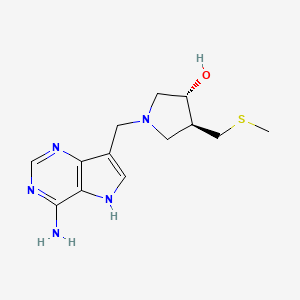
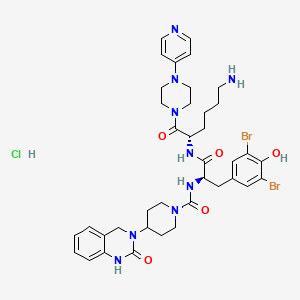
![(E)-[6]-Dehydroparadol](/img/structure/B1663509.png)
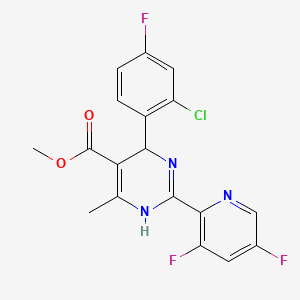
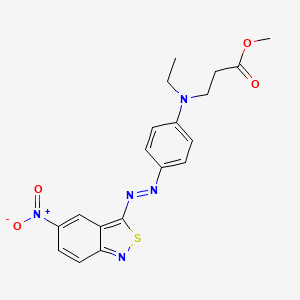
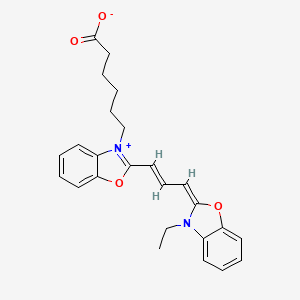
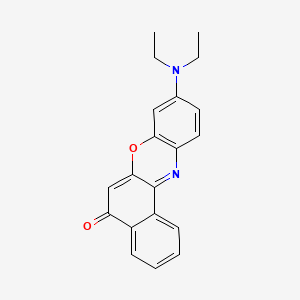
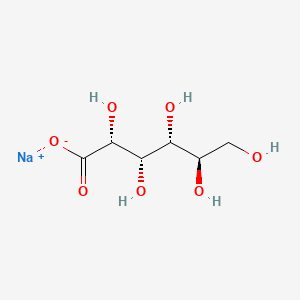
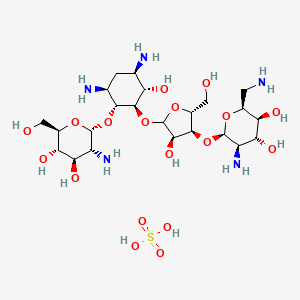
![methyl (4S)-2,6-dimethyl-5-nitro-4-[2-(trifluoromethyl)phenyl]-1,4-dihydropyridine-3-carboxylate](/img/structure/B1663520.png)
